
Wargentin is an unusual lunar impact crater which has been filled to its rim by a basaltic lava flow, forming a raised plateau. When the lava flow occurred, it erupted from within the crater walls and proceeded to accumulate until overrunning the lowest portion of the rim. Some blockage then prevented the lava flow from returning to equilibrium. Since the time when this occurred, some ejecta has been deposited across the top, giving the surface a higher albedo than is typical for deposits of basalt.
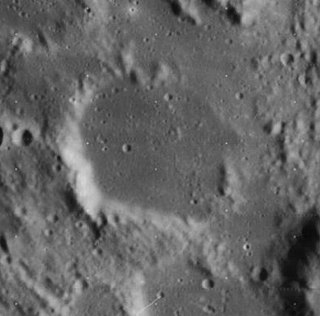
Dembowski is a lunar impact crater located to the southeast of the Sinus Medii. Its diameter is 26 km. It was named after Italian astronomer Ercole Dembowski. To the east are the craters Agrippa and Godin, to the southwest is Rhaeticus.
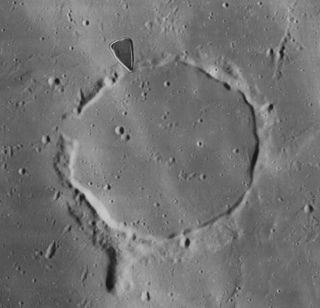
Kies is the remnant of a lunar impact crater that has been flooded by basaltic lava, leaving only a remnant of the outer rim. It was named after German mathematician and astronomer Johann Kies. It is located in the Mare Nubium almost due south of the crater Bullialdus. Northwest of Kies is König. To the south-southwest lies a lunar dome structure designated Kies Pi (π). It has a small crater at the top and is most likely volcanic in origin.

Lick is a lunar impact crater that has been flooded with basaltic lava. This crater was named in memory of James Lick, a Californian philanthropist. The north rim is attached to the smaller, bowl-shaped crater Greaves. Lick lies on the southwest edge of Mare Crisium. Its rim is broken at the north and south ends, and the southwest rim is attached to the crater remnant Lick A. There is a small, flooded crater within the southern part of Lick's inner floor, and several tiny craters mark the interior surface. A small, unnamed crater at the east rim has a bright ray system.

de Gasparis is a lunar crater that is located in the southwest part of the Moon. It lies to the southeast of the crater Cavendish and south of Mersenius.
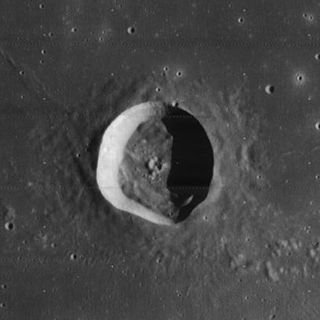
Flamsteed is a small lunar impact crater located on the Oceanus Procellarum, which is named after British astronomer John Flamsteed. It lies almost due east of the dark-hued Grimaldi, and north-northwest of the flooded Letronne bay on the south edge of the mare.
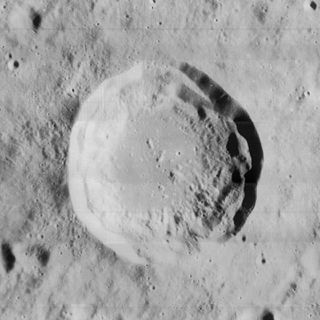
Mairan is a lunar impact crater that is located on a highland peninsula between Oceanus Procellarum to the west and Mare Imbrium to the east. To the north-northeast is the comparably sized crater Sharp. Northwest of Mairan is the heavily eroded Louville.

Artamonov is a lunar impact crater on the far side of the Moon. Its eroded outer rim does not have the circular shape of most lunar craters, but the overall shape of three or four merged craters. The largest is in the south, with smaller circular bulges to the north and east.

Balboa is a lunar impact crater that is located near the western limb of the Moon. Due to foreshortening, the crater appears highly oval when viewed from the Earth. In actuality, however, the formation is relatively circular. It is comparable in size to the crater Dalton, located just to the southwest. The eastern rim of Balboa lies just to the west of the Oceanus Procellarum.
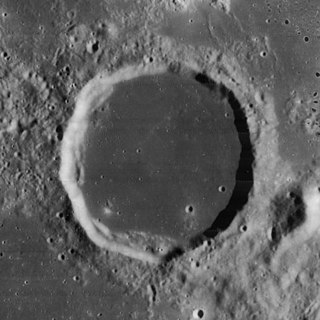
Billy is a lunar impact crater that is located at the southern fringes of the Oceanus Procellarum, in the western hemisphere of the Moon. It was named after French mathematician Jacques de Billy. It lies to the southeast of the similar-sized crater Hansteen, and west-southwest of the flooded Letronne.

Chamberlin is a lunar impact crater that is located on the far side of the Moon, just past the southeastern limb. It lies to the southeast of the crater Jeans, and Moulton is attached to the southeastern rim of Chamberlin. This crater is located in a part of the lunar surface that has undergone resurfacing of crater interiors, producing dark-hued crater floors.

D'Arrest is a lunar impact crater that is located in the lava-flooded region to the west of the Mare Tranquillitatis. It is named after the German astronomer Heinrich Louis d'Arrest. It lies to the southeast of the crater Agrippa and northwest of Delambre. Just to the northeast are the small, bowl-shaped craters De Morgan and Cayley.
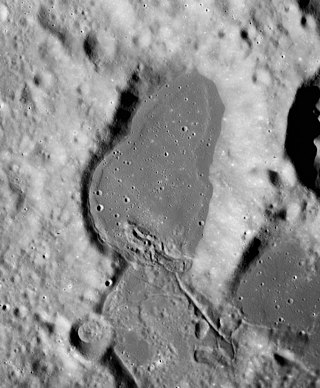
Bowditch is a lunar impact crater that lies on the far side of the Moon, just beyond the eastern limb. It is located on a region of the lunar surface that is brought into view due to libration, but at such times the area is viewed from the edge and so not much detail can be observed. It lies just to the north of the small Lacus Solitudinis lunar mare, between the craters Titius to the southwest and Perel'man to the east-northeast.
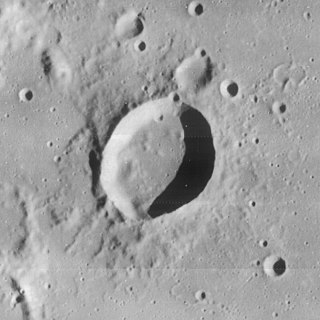
Clausius is a lunar impact crater that is located in the southwest part of the Moon, in the small lunar mare designated Lacus Excellentiae. It is completely enclosed by mare material, although the tiny satellite crater Clausius A lies just to the north. The rim of Clausius is low and sharp, with a slightly oval shape that is longer in the north–south direction. The interior floor has been flooded by basaltic lava, and appears level and featureless with a darker surface that matches the mare surface that surrounds the crater exterior.
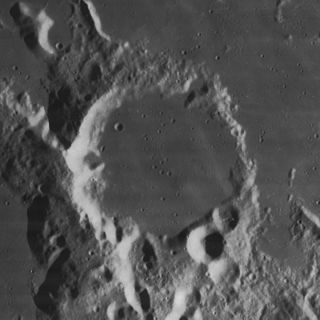
Capuanus is a lunar impact crater that lies along the southern edge of the Palus Epidemiarum. It was named after Italian astronomer F. Capuano di Manfredonia. The outer rim is eroded and indented by lesser crater impacts, with notches in the north, west, and southern parts of the rim. The interior floor has been resurfaced by basaltic lava, which is connected to the surrounding lunar mare by a narrow, crater-formed gap in the northern rim. Dotting the floor of the crater are a number of domes, which are believed to have formed through volcanic activity.

Spörer is a lunar impact crater that lies just to the north of the crater Herschel, and southeast of the lava-flooded Flammarion. To the southeast is Gyldén, and to the northeast is Réaumur.

Crozier is a lunar impact crater that is located on the southwest edge of Mare Fecunditatis, a lunar mare in the eastern part of the Moon's near side. It lies to the east-northeast of the prominent crater Colombo, and southeast of the small crater Bellot.

Daubrée is a lunar impact crater that is located to the southwest of the Mare Serenitatis, just to the west-southwest of the crater Menelaus in the Montes Haemus range. The small lunar mare Lacus Hiemalis lies along the southwest rim of Daubrée. The crater was named after French geologist Gabriel A. Daubrée. It was previously designated Menelaus S.

Chrétien is a lunar impact crater that is located in the southern hemisphere on the far side of the Moon from the Earth. It lies due south of the Mare Ingenii, one of the few maria on the Moon's far side. The crater lies in the midpoint between the craters Garavito to the west-southwest and Oresme to the east-northeast, both of these being somewhat smaller than Chrétien.
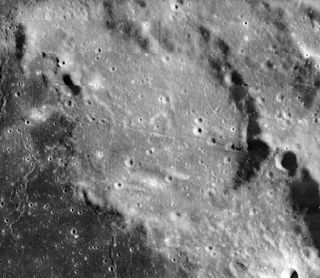
McAdie is a flooded lunar impact crater that is located along the northeastern edge of Mare Smythii, on the far side of the Moon. It lies just to the southwest of the larger, flooded Babcock. During periods of favorable libration and illumination, this area can be viewed from the Earth, although it is seen from the edge and not much detail can be discerned.























